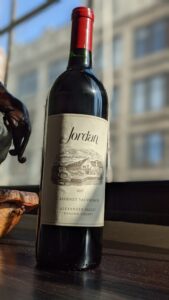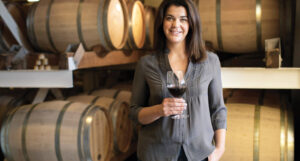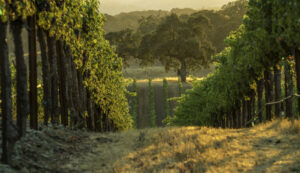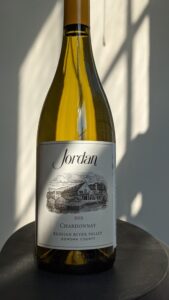As a little girl smelled intriguing aromas of grapes and leaves wafting in the air, her face beamed with a joyful curiosity as her parents drove her around Sonoma County and Napa Valley during harvest time for wine producers. Although her father worked for the Miller Brewery Company back in Milwaukee, Wisconsin, in the 70s and early 80s, he had a deep love for wine as well as the San Francisco Bay Area and his daughter not only grew up witnessing her parents’ love for wine at home but enjoyed the stories about the recent California graduates of University of California- Davis (U.C. Davis), which today has one of the top winemaking programs in the world; these graduates would come out to Miller to intern during those times – but would quickly run back to California once they experienced their first Midwestern winter. Although the Midwest is not known as a great winemaking area, it would end up being the home of the next winemaker at the helm of Jordan Vineyard & Winery, a producer in Alexander Valley in Sonoma County which is famous for their elegant, old-world style of Cabernet Sauvignon and Chardonnay wines.
Father and Top University Points Towards Wine
That little girl, Maggie Kruse, would end up excelling in science in high school and falling in love with hands-on work in the lab and so her dad suggested that she should go to the winemaking program at U.C. Davis. But she wanted to keep her options open and so she visited other well-respected universities but while she was checking out other schools, such as the prestigious school Barnard College, she talked about her interest in winemaking and going to U.C. Davis and she was instantly told she should definitely go for it since the winemaking path seemed so much more interesting than any other path she was considering – and this was from people trying to woo her to attend their schools.
Maggie was only 17 years old when she graduated from high school and so she did a year at Napa Valley College before going into U.C. Davis allowing her to have the amazing experience of living in Napa Valley at only 17 years old. “I would spend a lot of weekends driving around and getting a feel for things,” noted Maggie and she remembers driving to neighboring Sonoma County and loving how it could be quaint and have a small town vibe during the winter yet become energetic and vibrant during the summer and harvest time with people traveling there from all over the world. After graduating from U.C. Davis she became an intern at J Vineyards & Winery which so happened to be owned at the time by Judy Jordan, the sister of John Jordan – owner of Jordan Vineyard & Winery in Sonoma County as well. After spending a year with J Vineyards she ended up getting an assistant winemaking job at Jordan in 2006 and studying under longtime winemaker Rob Davis until he retired in 2019 giving way for Maggie to become the head winemaker.
Next Evolution of Jordan Vineyard & Winery
When John Jordan took over Jordan Vineyard & Winery from his parents in October in 2005 he went to head winemaker at the time Rob Davis and asked how they could make subtle changes over time to make the wine better as he wanted to make the best wine possible. Rob knew that it would be better to only use the best blocks from their estate vineyards as well as purchase fruit from long-time multi-generational family growers in the area instead of just using all the fruit from the estate. And so this would give them a chance to spend the next 15 years to analyze all of the different plots on their property to study the soil and various aspects of each section of vines and determine if the site could make great fruit by being replanted and reworked, or if it was going to be fruit that they would always sell off. Maggie said that through time they have really been able to get excellent fruit out of blocks that previously were not performing the way they wanted but even today John Jordan would never make her use a block that she thought was not worthy of the Jordan name; so she is grateful that she only places top lots of wine into the final blend making it possible to produce their elegant premium Cabernet Sauvignon every year.
Another exciting evolution for Jordan over the past 15 years has been to implement a cork sourcing program that would make sure they were getting the top performing corks in the world. From day one, Maggie was placed in charge of corks and so she would go through many of the batches of corks to see if there was any issues with TCA (a compound that has a moldy smell like wet cardboard) or any other off-aroma that would taint the wine and she would find too many instances of tainting off-aromas. Since screw caps just wouldn’t work for them, she decided that the Diam cork was the best type of cork to use. The process of Diam is fascinating as it is a cork that has been broken down into tiny pieces that goes through a “super critical process” that is similar to decaffeinated coffee and it takes out all of the off-aromas, not only TCA but Maggie says she has smelled “pine and ash tray characteristics” taken out and then microsphere adhesives are used to bind it all back together. One is not only left with a cork that has no taint of any kind but it is perfectly uniform and hence will have the same oxygen transmission rate for each cork – this translates into each bottle aging at the same rate as compared to regular corks which have imperfections that will have the same case of wine, for example, containing bottles which age at different rates.
Another step in their cork program involves their recently released 40th Anniversary of their Chardonnay and represents Maggie’s first vintage as head winemaker, 2019 Jordan Chardonnay, under the Origine closure by Diam which uses beeswax as a binder for the Diam cork making it a more natural product overall. Maggie has been trialing the Origine herself in their cellars for four years and she is impressed by the results and hence why she feels confident releasing the 2019 Chardonnay with it; the Cabernet Sauvignon does not have the Origine closure yet as she knows their customers age their Cabernet for many years so it may take ten, 15, maybe even 20 years before they decide to release their Cabernet under the Origine closure.
Jordan’s Chardonnay is sourced from the Russian River Valley in Sonoma County and Maggie has been part of the evolution of that wine as well as they have been sourcing more fruit from western parts of the Russian River with cooler temperatures which produces wines with more finesse. Also they have been recently experimenting with a concrete egg fermenter that they believe will bring more texture, as well as retain the distinctive minerality for their Chardonnay wine.
Timing Advantageous For Both
Maggie is so thankful that the timing worked out in her favor as not only did she get to have Rob Davis, the first winemaker for Jordan since 1976, as her mentor as well as take over for him in 2019 but she came at a time when John Jordan took over for his parents and he was open to change. Because of the timing she notes, “I was able to appreciate the way Jordan was doing things in the past as well as be really excited and enthusiastic about where our future was heading.” And although many of her wine colleagues used to joke about how long she stayed at Jordan since her arrival in 2006, as it is very unusual especially nowadays for winemakers to stay anywhere for a significant length of time, she couldn’t feel more fortunate that she found a place very early on that ideally suits her; she is challenged, constantly learning yet she is fully respected for the choices she makes and given the freedom to do what is best for the wines.
And by the same token, the timing worked out for Jordan Vineyard & Winery as after having their first winemaker for so long it would seem they wouldn’t be so lucky twice to find someone else who was such an ideal candidate to take Rob’s place and yes, it is more than understandable that many times it doesn’t work out and someone needs to go another way… but when it does work out with a passionate, hardworking and ever curious winemaker, it is a great sign that no matter how wonderful the wines are now, there is so much more to come.
***This article originally appeared in Forbes: https://www.forbes.com/sites/cathrinetodd/2021/12/27/fate-has-midwestern-woman-lead-sonoma-winery-to-next-evolution/?sh=5c02868072a0

Photo Credit:
Cathrine Todd
2019 Jordan Chardonnay, Russian River Valley, Sonoma County, California: 100% Chardonnay. A lovely balance of richness and brightness with notes of lemon custard and citrus blossom that has fresh acidity on the finish with a lasting note of wet stones.
2017 Jordan Cabernet Sauvignon, Alexander Valley, Sonoma Valley, California: 80% Cabernet Sauvignon, 10% Merlot, 8% Petit Verdot and 2% Malbec. Deep, rich blackberry flavors with added complexity of broken rocks and fresh sage with round tannins and long length of flavor with a wonderful balance that included plenty of fruit, freshness and overall elegance.















